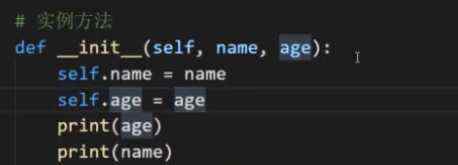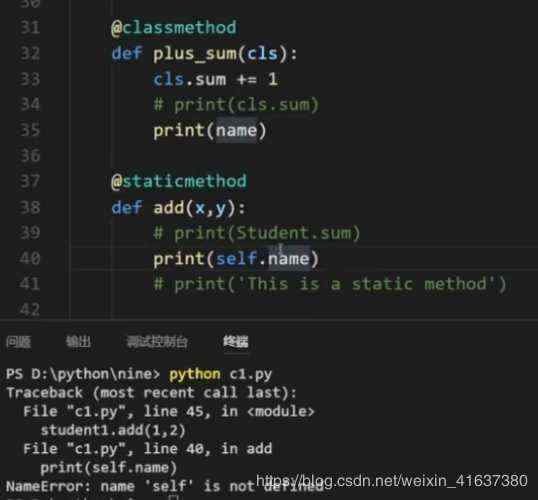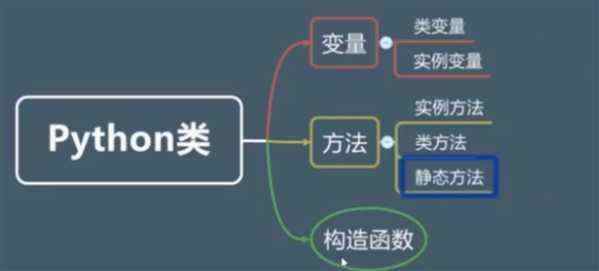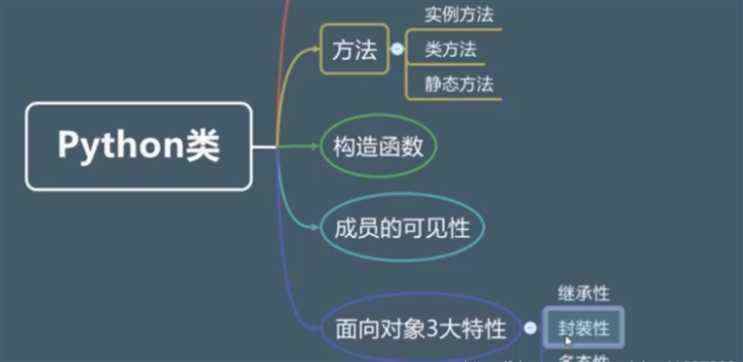作者:不乱于心丨不困于丶情 | 来源:互联网 | 2024-10-10 14:42
一.类的定义
1.
class Student():
name = ‘ ‘ #定义变量
age = 0
def print_file(self): #定义函数
print(‘name:‘ + self.name)
print(‘age:‘ + str(self.age))
class StudentHomework():
homework_name = ‘ ‘
#使用类需要对类进行实例化
student = Student()
student.print_file() #调用类下面的方法
- 类的最基本作用就是在封装代码。
- 类的内部不能调用类的方法,类只负责去描述和定义,而不负责执行,运行和调用类需要放在类的外部。
- 不推荐在一个模块中既定义类又使用类。
2.在一个模块中调用另一个模块的类:
#c2.py中的代码
from c1 import Student#Student类属于c1模块
student = Student()#实例化
student.print_file()#调用Student类中的print_file()方法
二.函数与方法的区别
方法是设计层面上的称谓,更多的是面向对象中的概念;
函数是程序运行的,面向过程的一种称谓。
没有必要特别的去区分方法和函数。
变量出现在类中更多称为数据成员。
三.构造函数
1.实例化创造不同的对象。
student1 = Student()
student2 = Student()
student3 = Student()
print(id(student1))
print(id(student2))
print(id(student3))
结果
#3269808
#3410256
#3410320
2.
def __init__(self):声明构造函数
- 构造函数的调用是自动进行的
- 我们可以去主动调用构造函数
- 对构造函数来说只能 return None
3.构造函数的作用
class Student():
name = ‘‘ #定义变量(类变量)
age = 0
def __init__(self,name,age):
#初始化对象的属性
name = name
age = age
student1 = Student(‘朱可爱‘,18)
print(student1.name,student1.age) #返回了空字符串
返回空字符串的原因:类变量和实例变量的原因,实质上返回的是类变量
尝试访问实例变量时:在实例变量列表里查找,如果没有会到类变量里面寻找。如果类中没有会到父类寻找。
模块中的类似情况:局部变量不会覆盖全局变量
c = 50
def add(x,y)
c = x + y #这个c不会覆盖全局变量的c
print(c)
结果:
3
50
四.类变量与实例变量
1.定义:
类变量:和类相关的变量(类变量不会受实例变量的影响)
实例变量:和对象相关联的变量
2.代码
class Student():
name = ‘cute‘
age = 0
def __init__(self,name,age):
self.name = name
self.age = age
student1 = Student(‘朱可爱‘,18) #实例变量
student2 = Student(‘朱cute‘,19)
print(student1.name)
print(student2.name)
print(Student.name)#类变量不会受实例变量的影响
结果:
#朱可爱
#朱cute
#cute#类变量不会受实例变量的影响
五.self与实例方法
1.如果在类中定义实例方法的话,要固定在类中放上self


2.self代表实例而不是类,注意:self不能称作关键字,self可以改为任意值,但是python建议使用self
3.实例方法是实例可以调用的方法,和对象实例相关联。
六.在实例方法中访问实例变量与类变量
1.在构造函数内部访问实例变量:
class Student():
name = ‘123‘
age = 0
sum = 0
def __init__(self,name,age):
self.name = name
self.age = age
print(self.name) #读取的是self.name,访问实例变量要加self
print(name) #读取的是形参的name,如果形参列表变成(self,name1,age),则会报错
student1 = Student(‘cute‘,18)
结果:
cute
cute
2.在实例方法中访问类变量:
print(Student.sum1) #第一种访问类变量的方式(类名.变量名)
print(self.__class__.sum1) #第二种访问类变量的方式
class Student():
name = ‘123‘
age = 0
sum1 = 0
def __init__(self,name,age):
self.name = name
self.age = age
print(Student.sum1) #第一种访问类变量的方式(类名.变量名)
print(self.__class__.sum1) #第二种访问类变量的方式
结果:
0
0
七.类方法
类变量的使用场景:
class Student():
name = ‘123‘
age = 0
sum1 = 0
def __init__(self,name,age):
self.name = name
self.age = age
self.__class__.sum1 += 1
print("当前班级人数为" + str(self.__class__.sum1))
student1 = Student(‘cute‘,18)
student2 = Student(‘朱cute‘,18)
student3 = Student(‘朱可爱‘,18)
结果:
#当前班级人数为1
#当前班级人数为2
#当前班级人数为3
1.定义类方法:
@classmethod #装饰器
def 方法名(cls): #class简写,cls代表调用类方法的类。cls可以换成别的名字,但是不建议更换
pass
2.类方法里操作类变量:(更改类变量的使用场景的代码)
class Student():
name = ‘123‘
age = 0
sum1 = 0
def __init__(self,name,age):
self.name = name
self.age = age
#self.__class__.sum1 += 1
#print("当前班级人数为" + str(self.__class__.sum1))
@classmethod
def plus_sum(cls):
cls.sum1 += 1
print(cls.sum1)
student1 = Student(‘cute‘,18)
Student.plus_sum() #调用类方法
student2 = Student(‘朱cute‘,18)
Student.plus_sum()
student3 = Student(‘朱可爱‘,18)
Student.plus_sum()
3.区别:实例方法关联对象,类方法关联类本身。
4.可以用对象调用类方法:
student1 = Student(‘cute‘,18)
student1.plus_sum() #可以,但是最好不要,在逻辑上说不通
八.静态方法
1.定义静态方法:
@staticmethod #装饰器
def 方法名(x,y): #没有指代
pass
2.静态方法能够被类和对象调用:
@staticmethod #装饰器
def add(x,y): #没有指代
print(‘This is a static method‘)
student1 = Student(‘cute‘,18)
student1.add(1,2) #被对象调用
Student.add(1,2) #被类调用
结果:
This is a static method
This is a static method
3.静态方法内部可以访问类变量
@staticmethod #装饰器
def add(x,y): #没有指代
print(Student.sum1) #可以访问类变量
print(‘This is a static method‘)
4.静态方法和类方法都无法访问实例变量。

5.能用静态方法的时候都可用类方法替代,最好不要经常使用,与类和对象的关联性非常弱,和普通的函数几乎没有区别。


九. 成员可见性:公开和私有
1.成员需要有一定的调用层级,以打分为例:
class Student():
name = ‘123‘
age = 0
sum1 = 0
score = 0
def __init__(self,name,age):
self.name = name
self.age = age
self.score = 0
def marking(self,score):
if score <0: #可以对数据进行判断
score = 0
self.score = score
print(self.name + ‘本次考试分数为‘ + str(self.score))
student1 = Student(‘cute‘,18)
student1.marking(100) #利用marking方法打分
2.
不加双下划线:公开
加双下划线:私有 eg:__add
前后都有双下划线:公开,是python内置函数的命名风格。eg:__init__():
3.尝试从外部访问私有变量:
class Student():
def __init__(self,name,age):
self.name = name
self.age = age
self.__score = 0
def marking(self,__score):
if __score < 0:
__score = 0
self.__score = __score
print(self.name + ‘本次考试分数为‘ + str(self.__score))
student1 = Student(‘cute‘,18)
student1.marking(100)
student1.__score = -1 #没有报错
print(student1.__score)
结果:
100
-1
__score不是私有变量吗?为什么在外部赋值又可以访问呢?因为,student1.__score = -1 实际上是给sutdent1新添加了一个实例变量。
举例:如果没有新添加,是不能在外部访问私有变量
class Student():
def __init__(self,name,age):
self.name = name
self.age = age
self.__score = 0
def marking(self,__score):
if __score < 0:
__score = 0
self.__score = __score
print(self.name + ‘本次考试分数为‘ + str(self.__score))
student1 = Student(‘cute‘,18)
student2 = Student(‘朱cute‘,19)
student1.marking(100)
student1.__score = -1 #实际上是利用python动态特性,给student1添加了一个新的属性叫__score,
并不是实例变量中的__score
print(student1.__score) #结果:-1
print(student2.__score) #报错了
通过这种方式可以间接的读取私有变量:单下划线 + 类名 + 双下划线 + 实例变量名
举例:
print(student2._Student__score) #读取到了私有变量,不会报错
结果:本次考试分数为59